Opening hostilities
Confusion among the Central Powers
The strategy of the Central Powers suffered from miscommunication. Germany had promised to support Austria-Hungary's invasion of Serbia, but interpretations of what this meant differed. Previously tested deployment plans had been replaced early in 1914, but never tested in exercises. Austro-Hungarian leaders believed Germany would cover its northern flank against Russia. Germany, however, envisioned Austria-Hungary directing the majority of its troops against Russia, while Germany dealt with France. This confusion forced the Austro-Hungarian Army to divide its forces between the Russian and Serbian fronts.On 9 September 1914, the Septemberprogramm, a possible plan which detailed Germany's specific war aims and the conditions that Germany sought to force upon the Allied Powers, was outlined by German Chancellor Theobald von Bethmann-Hollweg. It was never officially adopted.
African campaigns
Main article: African theatre of World War I
Some of the first clashes of the war involved British, French and German colonial forces in Africa. On 7 August, French and British troops invaded the German protectorate of Togoland. On 10 August, German forces in South-West Africa attacked South Africa; sporadic and fierce fighting continued for the remainder of the war. The German colonial forces in German East Africa, led by Colonel Paul Emil von Lettow-Vorbeck, fought a guerrilla warfare campaign for the duration of World War I, only surrendering two weeks after the armistice took effect in Europe.Serbian campaign
Main article: Serbian Campaign (World War I)
The Serbian army fought the Battle of Cer against the invading Austro-Hungarians, beginning on 12 August, occupying defensive positions on the south side of the Drina and Sava rivers. Over the next two weeks Austrian attacks were thrown back with heavy losses, which marked the first major Allied victory of the war and dashed Austro-Hungarian hopes of a swift victory. As a result, Austria had to keep sizeable forces on the Serbian front, weakening its efforts against Russia.German forces in Belgium and France
Main article: Western Front (World War I)
At the outbreak of the First World War, the German army (consisting in the West of seven field armies) executed a modified version of the Schlieffen Plan, designed to quickly attack France through neutral Belgium before turning southwards to encircle the French army on the German border. The plan called for the right flank of the German advance to converge on Paris and initially, the Germans were very successful, particularly in the Battle of the Frontiers (14–24 August). By 12 September, the French with assistance from the British forces halted the German advance east of Paris at the First Battle of the Marne (5–12 September). The last days of this battle signified the end of mobile warfare in the west. The French offensive into Germany launched on 7 August with the Battle of Mulhouse had limited success.In the east, only one Field Army defended East Prussia and when Russia attacked in this region it diverted German forces intended for the Western Front. Germany defeated Russia in a series of battles collectively known as the First Battle of Tannenberg (17 August – 2 September), but this diversion exacerbated problems of insufficient speed of advance from rail-heads not foreseen by the German General Staff. The Central Powers were thereby denied a quick victory and forced to fight a war on two fronts. The German army had fought its way into a good defensive position inside France and had permanently incapacitated 230,000 more French and British troops than it had lost itself. Despite this, communications problems and questionable command decisions cost Germany the chance of obtaining an early victory.
Asia and the Pacific
Main article: Asian and Pacific theatre of World War I
New Zealand occupied German Samoa (later Western Samoa) on 30 August. On 11 September, the Australian Naval and Military Expeditionary Force landed on the island of Neu Pommern (later New Britain), which formed part of German New Guinea. Japan seized Germany's Micronesian colonies and, after the Siege of Tsingtao, the German coaling port of Qingdao in the Chinese Shandong peninsula. Within a few months, the Allied forces had seized all the German territories in the Pacific; only isolated commerce raiders and a few holdouts in New Guinea remained.Early stages
Trench warfare begins
Main article: Western Front (World War I)
Military tactics before World War I had failed to keep pace with advances in technology. These changes resulted in the building of impressive defence systems, which out of date tactics could not break through for most of the war. Barbed wire was a significant hindrance to massed infantry advances. Artillery, vastly more lethal than in the 1870s, coupled with machine guns, made crossing open ground very difficult. The Germans introduced poison gas; it soon became used by both sides, though it never proved decisive in winning a battle. Its effects were brutal, causing slow and painful death, and poison gas became one of the most-feared and best-remembered horrors of the war. Commanders on both sides failed to develop tactics for breaching entrenched positions without heavy casualties.In time, however, technology began to produce new offensive weapons, such as the tank. Britain and France were its primary users; the Germans employed captured Allied tanks and small numbers of their own design. After the First Battle of the Marne, both Entente and German forces began a series of outflanking manoeuvres, in the so-called "Race to the Sea". Britain and France soon found themselves facing entrenched German forces from Lorraine to Belgium's coast. Britain and France sought to take the offensive, while Germany defended the occupied territories; consequently, German trenches were generally much better constructed than those of their enemy. Anglo-French trenches were only intended to be "temporary" before their forces broke through German defences. Both sides attempted to break the stalemate using scientific and technological advances. On 22 April 1915 at the Second Battle of Ypres, the Germans (in violation of the Hague Convention) used chlorine gas for the first time on the Western Front. Algerian troops retreated when gassed and a six kilometre (four mile) hole opened in the Allied lines that the Germans quickly exploited, taking Kitcheners' Wood. Canadian soldiers closed the breach at the Second Battle of Ypres. At the Third Battle of Ypres, Canadian and ANZAC troops took the village of Passchendaele.

In the trenches: Royal Irish Rifles in a communications trench on the first day on the Somme, 1 July 1916.
Neither side proved able to deliver a decisive blow for the next two years, though protracted German action at Verdun throughout 1916, combined with the bloodletting at the Somme, brought the exhausted French army to the brink of collapse. Futile attempts at frontal assault came at a high price for both the British and the French poilu (infantry) and led to widespread mutinies, especially during the Nivelle Offensive.
Throughout 1915–17, the British Empire and France suffered more casualties than Germany, due both to the strategic and tactical stances chosen by the sides. At the strategic level, while the Germans only mounted a single main offensive at Verdun, the Allies made several attempts to break through German lines. At the tactical level, German commander Erich Ludendorff's doctrine of "elastic defence" was well suited for trench warfare. This defence had a relatively lightly defended forward position and a more powerful main position farther back beyond artillery range, from which an immediate and powerful counter-offensive could be launched.
Ludendorff wrote on the fighting in 1917,
On the battle of the Menin Road Ridge, Ludendorff wrote,The 25th of August concluded the second phase of the Flanders battle. It had cost us heavily ... The costly August battles in Flanders and at Verdun imposed a heavy strain on the Western troops. In spite of all the concrete protection they seemed more or less powerless under the enormous weight of the enemy’s artillery. At some points they no longer displayed the firmness which I, in common with the local commanders, had hoped for. The enemy managed to adapt himself to our method of employing counter attacks ... I myself was being put to a terrible strain. The state of affairs in the West appeared to prevent the execution of our plans elsewhere. Our wastage had been so high as to cause grave misgivings, and had exceeded all expectation.
Another terrific assault was made on our lines on the 20 September ... The enemy’s onslaught on the 20th was successful, which proved the superiority of the attack over the defence. Its strength did not consist in the tanks; we found them inconvenient, but put them out of action all the same. The power of the attack lay in the artillery, and in the fact that ours did not do enough damage to the hostile infantry as they were assembling, and above all, at the actual time of the assault.

Officers and senior enlisted men of the Bermuda Militia Artillery's Bermuda Contingent, Royal Garrison Artillery, in Europe.
In the 1917 Battle of Arras, the only significant British military success was the capture of Vimy Ridge by the Canadian Corps under Sir Arthur Currie and Julian Byng. The assaulting troops were able for the first time to overrun, rapidly reinforce and hold the ridge defending the coal-rich Douai plain.
Main article: Naval warfare of World War I
At the start of the war, the German Empire had cruisers scattered across the globe, some of which were subsequently used to attack Allied merchant shipping. The British Royal Navy systematically hunted them down, though not without some embarrassment from its inability to protect Allied shipping. For example, the German detached light cruiser SMS Emden, part of the East-Asia squadron stationed at Tsingtao, seized or destroyed 15 merchantmen, as well as sinking a Russian cruiser and a French destroyer. However, the bulk of the German East-Asia squadron—consisting of the armoured cruisers Scharnhorst and Gneisenau, light cruisers Nürnberg and Leipzig and two transport ships—did not have orders to raid shipping and was instead underway to Germany when it encountered elements of the British fleet. The German flotilla, along with Dresden, sank two armoured cruisers at the Battle of Coronel, but was almost destroyed at the Battle of the Falkland Islands in December 1914, with only Dresden and a few auxiliaries escaping, but at the Battle of Más a Tierra these too were destroyed or interned.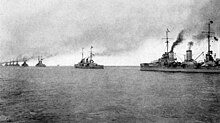
A battleship squadron of the Hochseeflotte at sea
The 1916 Battle of Jutland (German: Skagerrakschlacht, or "Battle of the Skagerrak") developed into the largest naval battle of the war, the only full-scale clash of battleships during the war, and one of the largest in history. It took place on 31 May – 1 June 1916, in the North Sea off Jutland. The Kaiserliche Marine's High Seas Fleet, commanded by Vice Admiral Reinhard Scheer, squared off against the Royal Navy's Grand Fleet, led by Admiral Sir John Jellicoe. The engagement was a stand off, as the Germans, outmanoeuvred by the larger British fleet, managed to escape and inflicted more damage to the British fleet than they received. Strategically, however, the British asserted their control of the sea, and the bulk of the German surface fleet remained confined to port for the duration of the war.
German U-boats attempted to cut the supply lines between North America and Britain. The nature of submarine warfare meant that attacks often came without warning, giving the crews of the merchant ships little hope of survival. The United States launched a protest, and Germany modified its rules of engagement. After the notorious sinking of the passenger ship RMS Lusitania in 1915, Germany promised not to target passenger liners, while Britain armed its merchant ships, placing them beyond the protection of the "cruiser rules" which demanded warning and placing crews in "a place of safety" (a standard which lifeboats did not meet). Finally, in early 1917 Germany adopted a policy of unrestricted submarine warfare, realising the Americans would eventually enter the war. Germany sought to strangle Allied sea lanes before the U.S. could transport a large army overseas, but were only able to maintain five long range U-boats on station, to limited effect.
The U-boat threat lessened in 1917, when merchant ships entered convoys escorted by destroyers. This tactic made it difficult for U-boats to find targets, which significantly lessened losses; after the introduction of hydrophone and depth charges, accompanying destroyers might attack a submerged submarine with some hope of success. The convoy system slowed the flow of supplies, since ships had to wait as convoys were assembled. The solution to the delays was an extensive program to build new freighters. Troop ships were too fast for the submarines and did not travel the North Atlantic in convoys. The U-boats had sunk almost 5,000 Allied ships, at a cost of 178 submarines.
World War I also saw the first use of aircraft carriers in combat, with HMS Furious launching Sopwith Camels in a successful raid against the Zeppelin hangars at Tondern in July 1918, as well as blimps for antisubmarine patrol.
Southern theatres
War in the Balkans
Main articles: Balkans Campaign (World War I), Serbian Campaign (World War I), and Macedonian front (World War I)
Serbia was conquered in a little more than a month. The attack began in October, when the Central Powers launched an offensive from the north; four days later the Bulgarians joined the attack from the east. The Serbian army, fighting on two fronts and facing certain defeat, retreated into Albania, halting only once to make a stand against the Bulgarians. The Serbs suffered defeat near modern day Gnjilane in the Battle of Kosovo. Montenegro covered the Serbian retreat towards the Adriatic coast in the Battle of Mojkovac in 6–7 January 1916, but ultimately the Austrians conquered Montenegro, too. Serbian forces were evacuated by ship to Greece.
In late 1915, a Franco-British force landed at Salonica in Greece, to offer assistance and to pressure the government to declare war against the Central Powers. Unfortunately for the Allies, the pro-German King Constantine I dismissed the pro-Allied government of Eleftherios Venizelos, before the Allied expeditionary force could arrive.
The Macedonian Front proved static for the most part. Serbian forces retook part of Macedonia by recapturing Bitola on 19 November 1916. Only at the end of the conflict were the Entente powers able to break through, after most of the German and Austro-Hungarian troops had withdrawn. The Bulgarians suffered their only defeat of the war at the Battle of Dobro Pole but days later, they decisively defeated British and Greek forces at the Battle of Doiran, avoiding occupation. Bulgaria signed an armistice on 29 September 1918. Hindenburg and Ludendorff concluded that the strategic and operational balance had now shifted decidedly against the Central Powers and a day after the Bulgarian collapse, during a meeting with government officials, insisted on an immediate peace settlement.
The disappearance of the Macedonian front meant that the road to Budapest and Vienna was now opened for the 670,000-strong army of general Franchet d'Esperey as the Bulgarian capitulation deprived the Central Powers of the 278 infantry battalions and 1,500 guns (the equivalent of some 25 to 30 German divisions) that were previously holding the line. The German high command was able to respond by sending in only seven infantry and one cavalry division but these forces were far from sufficient for a front to be reestablished.
Ottoman Empire
Main article: Middle Eastern theatre of World War I
The Ottoman Empire joined the Central Powers in the war, the secret Ottoman-German Alliance having been signed in August 1914. It threatened Russia's Caucasian territories and Britain's communications with India via the Suez Canal. The British and French opened overseas fronts with the Gallipoli (1915) and Mesopotamian campaigns. In Gallipoli, the Ottoman Empire successfully repelled the British, French and Australian and New Zealand Army Corps (ANZACs). In Mesopotamia, by contrast, after the disastrous Siege of Kut (1915–16), British Imperial forces reorganised and captured Baghdad in March 1917. Further to the west, in the Sinai and Palestine Campaign, initial British setbacks were overcome when they captured Jerusalem in December 1917. The Egyptian Expeditionary Force, under Field Marshal Edmund Allenby, broke the Ottoman forces at the Battle of Megiddo in September 1918.Russian armies generally had the best of it in the Caucasus. Enver Pasha, supreme commander of the Ottoman armed forces, was ambitious and dreamed of re-conquering central Asia, and areas that had been lost to Russia previously. He was, however, a poor commander. He launched an offensive against the Russians in the Caucasus in December 1914 with 100,000 troops; insisting on a frontal attack against mountainous Russian positions in winter, he lost 86% of his force at the Battle of Sarikamish.
General Yudenich, the Russian commander from 1915 to 1916, drove the Turks out of most of the southern Caucasus with a string of victories. In 1917, Russian Grand Duke Nicholas assumed command of the Caucasus front. Nicholas planned a railway from Russian Georgia to the conquered territories, so that fresh supplies could be brought up for a new offensive in 1917. However, in March 1917, (February in the pre-revolutionary Russian calendar), the Czar was overthrown in the February Revolution and the Russian Caucasus Army began to fall apart.

German soldiers in Jerusalem
Instigated by the Arab bureau of the British Foreign and Commonwealth Office, the Arab Revolt started with the help of Britain in June 1916 at the Battle of Mecca, led by Sherif Hussein of Mecca, and ended with the Ottoman surrender of Damascus. Fakhri Pasha, the Ottoman commander of Medina, resisted for more than two and half years during the Siege of Medina.
Along the border of Italian Libya and British Egypt, the Senussi tribe, incited and armed by the Turks, waged a small-scale guerrilla war against Allied troops. The British were forced to dispatch 12,000 troops to deal with the Senussi. Their rebellion was finally crushed in mid-1916.
Italian participation
Main article: Italian Campaign (World War I)
Further information: Battles of the Isonzo
Italy had been allied with the German and Austro-Hungarian Empires since 1882 as part of the Triple Alliance. However, the nation had its own designs on Austrian territory in Trentino, Istria and Dalmatia. Rome had a secret 1902 pact with France, effectively nullifying its alliance. At the start of hostilities, Italy refused to commit troops, arguing that the Triple Alliance was defensive in nature, and that Austria–Hungary was an aggressor. The Austro-Hungarian government began negotiations to secure Italian neutrality, offering the French colony of Tunisia in return. The Allies made a counter-offer in which Italy would receive the Southern Tyrol, Julian March and territory on the Dalmatian coast after the defeat of Austria-Hungary. This was formalised by the Treaty of London. Further encouraged by the Allied invasion of Turkey in April 1915, Italy joined the Triple Entente and declared war on Austria-Hungary on 23 May. Fifteen months later Italy declared war on Germany.Militarily, the Italians had numerical superiority. This advantage, however, was lost, not only because of the difficult terrain in which fighting took place, but also because of the strategies and tactics employed. Field Marshal Luigi Cadorna, a staunch proponent of the frontal assault, had dreams of breaking into the Slovenian plateau, taking Ljubljana and threatening Vienna. It was a Napoleonic plan, which had no realistic chance of success in an age of barbed wire, machine guns, and indirect artillery fire, combined with hilly and mountainous terrain.
On the Trentino front, the Austro-Hungarians took advantage of the mountainous terrain, which favoured the defender. After an initial strategic retreat, the front remained largely unchanged, while Austrian Kaiserschützen and Standschützen engaged Italian Alpini in bitter hand-to-hand combat throughout the summer. The Austro-Hungarians counter attacked in the Altopiano of Asiago, towards Verona and Padua, in the spring of 1916, (Strafexpedition), but made little progress.
Beginning in 1915, the Italians under Cadorna mounted eleven offensives on the Isonzo front along the Isonzo River, north east of Trieste. All eleven offensives were repelled by the Austro-Hungarians, who held the higher ground. In the summer of 1916, the Italians captured the town of Gorizia. After this minor victory, the front remained static for over a year, despite several Italian offensives. In the autumn of 1917, thanks to the improving situation on the Eastern front, the Austro-Hungarian troops received large numbers of reinforcements, including German Stormtroopers and the elite Alpenkorps. The Central Powers launched a crushing offensive on 26 October 1917, spearheaded by the Germans. They achieved a victory at Caporetto. The Italian army was routed and retreated more than 100 kilometres (60 mi.) to reorganise, stabilising the front at the Piave River. Since in the Battle of Caporetto the Italian Army had heavy losses, the Italian Government called to arms the so-called '99 Boys (Ragazzi del '99), that is, all males who were 18 years old. In 1918, the Austro-Hungarians failed to break through, in a series of battles on the Piave River and, finally being decisively defeated in the Battle of Vittorio Veneto in October of that year. Austria-Hungary surrendered in early November 1918.
Romanian participation
Main article: Romania during World War I

Marshal Joffre inspecting Romanian troops
In January 1918, Romanian forces established control over Bessarabia as the Russian Army abandoned the province. Although a treaty was signed by the Romanian and the Bolshevik Russian government following talks between 5–9 March 1918 on the withdrawal of Romanian forces from Bessarabia within two months, on 27 March 1918 Romania attached Bessarabia to its territory, formally based on a resolution passed by the local assembly of the territory on the unification with Romania.
Romania officially made peace with the Central Powers by signing the Treaty of Bucharest on 7 May 1918. Under that treaty Romania was obliged to cease war with the Central Powers and make small territorial concessions for Austria-Hungary, ceding control of some passes in the Carpathian Mountains and grant oil concessions for Germany. In exchange, the Central Powers recognised the sovereignty of Romania over Bessarabia. The treaty was renounced in October 1918 by the Alexandru Marghiloman government and Romania nominally re-entered the war on 10 November 1918. The next day, the Treaty of Bucharest was nullified by the terms of the Armistice of Compiègne. Total Romanian deaths from 1914 to 1918, military and civilian, within contemporary borders, were estimated at 748,000.
The role of India
Further information: Third Anglo-Afghan War and Hindu-German Conspiracy
The war began with an unprecedented outpouring of loyalty and goodwill towards the United Kingdom from within the mainstream political leadership, contrary to initial British fears of an Indian revolt. The Indian Army in fact outnumbered the British Army at the beginning of the war. India under British rule contributed greatly to the British war effort by providing men and resources. This was done by the Indian Congress in hope of achieving self-government as India was very much under the control of the British. The United Kingdom disappointed the Indians by not providing self-governance, leading to the Gandhian Era in Indian history. About 1.3 million Indian soldiers and labourers served in Europe, Africa, and the Middle East, while both the Indian government and the princes sent large supplies of food, money, and ammunition. In all 140,000 men served on the Western Front and nearly 700,000 in the Middle East. Casualties of Indian soldiers totalled 47,746 killed and 65,126 wounded during World War I.Eastern Front
Initial actions
Main article: Eastern Front (World War I)
While the Western Front had reached stalemate, the war continued in East Europe. Initial Russian plans called for simultaneous invasions of Austrian Galicia and German East Prussia. Although Russia's initial advance into Galicia was largely successful, they were driven back from East Prussia by Hindenburg and Ludendorff at Tannenberg and the Masurian Lakes in August and September 1914. Russia's less developed industrial base and ineffective military leadership was instrumental in the events that unfolded. By the spring of 1915, the Russians had retreated into Galicia, and in May the Central Powers achieved a remarkable breakthrough on Poland's southern frontiers. On 5 August they captured Warsaw and forced the Russians to withdraw from Poland.Russian Revolution
Main article: Russian Revolution (1917)
Further information: North Russia Campaign
Despite the success of the June 1916 Brusilov Offensive in eastern Galicia, dissatisfaction with the Russian government's conduct of the war grew. The success was undermined by the reluctance of other generals to commit their forces to support the victory. Allied and Russian forces were revived only temporarily with Romania's entry into the war on 27 August. German forces came to the aid of embattled Austro-Hungarian units in Transylvania and Bucharest fell to the Central Powers on 6 December. Meanwhile, unrest grew in Russia, as the Tsar remained at the front. Empress Alexandra's increasingly incompetent rule drew protests and resulted in the murder of her favourite, Rasputin, at the end of 1916.In March 1917, demonstrations in Petrograd culminated in the abdication of Tsar Nicholas II and the appointment of a weak Provisional Government which shared power with the Petrograd Soviet socialists. This arrangement led to confusion and chaos both at the front and at home. The army became increasingly ineffective.

Signing the Treaty of Brest-Litovsk (February 9, 1918) are: 1. Count Ottokar von Czernin, 2. Richard von Kühlmann, and 3. Vasil Radoslavov
With the adoption of the Treaty of Brest-Litovsk, the Entente no longer existed. The Allied powers led a small-scale invasion of Russia, partly to stop Germany from exploiting Russian resources and, to a lesser extent, to support the "Whites" (as opposed to "Reds") in the Russian Civil War. Allied troops landed in Archangel and in Vladivostok.
Central Powers proposal for starting peace negotiations
In December 1916, after ten brutal months of the Battle of Verdun and a successful offensive against Romania, the Germans attempted to negotiate a peace with the Allies. Soon after, U.S. President Wilson attempted to intervene as a peacemaker, asking in a note for both sides to state their demands. Lloyd George's War Cabinet considered the German offer as a ploy to create divisions amongst the Allies. After initial outrage and much deliberation, they took Wilson's note as a separate effort, signalling that the U.S. was on the verge of entering the war against Germany following the "submarine outrages". While the Allies debated a response to Wilson's offer, the Germans chose to rebuff it in favour of "a direct exchange of views". Learning of the German response, the Allied governments were free to make clear demands in their response of 14 January. They sought restoration of damages, the evacuation of occupied territories, reparations for France, Russia and Romania, and a recognition of the principle of nationalities. This included the liberation of Italians, Slavs, Romanians, Czecho-Slovaks, and the creation of a "free and united Poland". On the question of security, the Allies sought guarantees that would prevent or limit future wars, complete with sanctions, as a condition of any peace settlement. The negotiations failed and the Entente powers rejected the German offer, because Germany did not state any specific proposals. To Wilson the Entente powers stated, that they will not start peace negotiations until the Central powers evacuated all occupied Allied territories and provided indemnities for all damage which was done.1917–1918
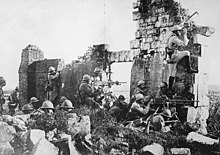
French troopers under General Gouraud, with their machine guns amongst the ruins of a cathedral near the Marne, driving back the Germans. 1918
Developments in 1917
Events of 1917 proved decisive in ending the war, although their effects were not fully felt until 1918.The British naval blockade began to have a serious impact on Germany. In response, in February 1917, the German General Staff convinced Chancellor Theobald von Bethmann-Hollweg to declare unrestricted submarine warfare, with the goal of starving Britain out of the war. Tonnage sunk rose above 500,000 tons per month from February to July. It peaked at 860,000 tons in April. After July, the newly re-introduced convoy system became extremely effective in reducing the U-boat threat. Britain was safe from starvation and German industrial output fell.
On 3 May 1917, during the Nivelle Offensive, the weary French 2nd Colonial Division, veterans of the Battle of Verdun, refused their orders, arriving drunk and without their weapons. Their officers lacked the means to punish an entire division, and harsh measures were not immediately implemented. Then, mutinies afflicted an additional 54 French divisions and saw 20,000 men desert. The other Allied forces attacked but sustained tremendous casualties. However, appeals to patriotism and duty, as well as mass arrests and trials, encouraged the soldiers to return to defend their trenches, although the French soldiers refused to participate in further offensive action. Robert Nivelle was removed from command by 15 May, replaced by General Philippe Pétain, who suspended bloody large-scale attacks.

Haut-Rhin, France, 1917
In December, the Central Powers signed an armistice with Russia. This released large numbers of German troops for use in the west. With German reinforcements and new American troops pouring in, the outcome was to be decided on the Western front. The Central Powers knew that they could not win a protracted war, but they held high hopes for success based on a final quick offensive. Furthermore, the leaders of the Central Powers and the Allies became increasingly fearful of social unrest and revolution in Europe. Thus, both sides urgently sought a decisive victory.
Entry of the United States
Main article: American entry into World War I
Non-Intervention
The United States originally pursued a policy of non-intervention, avoiding conflict while trying to broker a peace. When a German U-boat sank the British liner Lusitania in 1915, with 128 Americans aboard, U.S. President Woodrow Wilson vowed, "America is too proud to fight" and demanded an end to attacks on passenger ships. Germany complied. Wilson unsuccessfully tried to mediate a settlement. He repeatedly warned the U.S. would not tolerate unrestricted submarine warfare, in violation of international law and U.S. ideas of human rights. Wilson was under pressure from former president Theodore Roosevelt, who denounced German acts as "piracy". Wilson's desire to have a seat at negotiations at war's end to advance the League of Nations also played a role. Wilson's Secretary of State, William Jennings Bryan, whose opinions had been ignored, resigned as he could no longer support the president's policy. Public opinion was angered at suspected German sabotage of Black Tom in Jersey City, New Jersey, and the Kingsland Explosion.In January 1917, Germany resumed unrestricted submarine warfare. The German Foreign minister, in the Zimmermann Telegram, told Mexico that U.S. entry was likely once unrestricted submarine warfare began, and invited Mexico to join the war as Germany's ally against the United States. In return, the Germans would send Mexico money and help it recover the territories of Texas, New Mexico, and Arizona that Mexico lost during the Mexican-American War 70 years earlier. Wilson released the Zimmerman note to the public and Americans saw it as a casus bellum—a cause for war.
U.S. declaration of war on Germany
| Wikisource has original text related to this article: |
First active U.S. participation
The United States was never formally a member of the Allies but became a self-styled "Associated Power". The United States had a small army, but, after the passage of the Selective Service Act, it drafted 2.8 million men and by summer 1918 was sending 10,000 fresh soldiers to France every day. In 1917, the U.S. Congress gave U.S. citizenship to Puerto Ricans when they were drafted to participate in World War I, as part of the Jones Act. Germany had miscalculated, believing it would be many more months before they would arrive and that the arrival could be stopped by U-boats.The United States Navy sent a battleship group to Scapa Flow to join with the British Grand Fleet, destroyers to Queenstown, Ireland and submarines to help guard convoys. Several regiments of U.S. Marines were also dispatched to France. The British and French wanted U.S. units used to reinforce their troops already on the battle lines and not waste scarce shipping on bringing over supplies. The U.S. rejected the first proposition and accepted the second. General John J. Pershing, American Expeditionary Forces (AEF) commander, refused to break up U.S. units to be used as reinforcements for British Empire and French units. As an exception, he did allow African-American combat regiments to be used in French divisions. The Harlem Hellfighters fought as part of the French 16th Division, earning a unit Croix de guerre for their actions at Chateau-Thierry, Belleau Wood and Sechault. AEF doctrine called for the use of frontal assaults, which had long since been discarded by British Empire and French commanders because of the large loss of life.
Austrian offer of separate peace
In 1917, Emperor Charles I of Austria secretly attempted separate peace negotiations with Clemenceau, with his wife's brother Sixtus in Belgium as an intermediary, without the knowledge of Germany. When the negotiations failed, his attempt was revealed to Germany, a diplomatic catastrophe.German Spring Offensive of 1918
Main article: Spring Offensive
German General Erich Ludendorff drew up plans (codenamed Operation Michael) for the 1918 offensive on the Western Front. The Spring Offensive sought to divide the British and French forces with a series of feints and advances. The German leadership hoped to strike a decisive blow before significant U.S. forces arrived. The operation commenced on 21 March 1918 with an attack on British forces near Amiens. German forces achieved an unprecedented advance of 60 kilometres (40 miles).British and French trenches were penetrated using novel infiltration tactics, also named Hutier tactics, after General Oskar von Hutier. Previously, attacks had been characterised by long artillery bombardments and massed assaults. However, in the Spring Offensive of 1918, Ludendorff used artillery only briefly and infiltrated small groups of infantry at weak points. They attacked command and logistics areas and bypassed points of serious resistance. More heavily armed infantry then destroyed these isolated positions. German success relied greatly on the element of surprise.
The front moved to within 120 kilometres (75 mi) of Paris. Three heavy Krupp railway guns fired 183 shells on the capital, causing many Parisians to flee. The initial offensive was so successful that Kaiser Wilhelm II declared 24 March a national holiday. Many Germans thought victory was near. After heavy fighting, however, the offensive was halted. Lacking tanks or motorised artillery, the Germans were unable to consolidate their gains. This situation was not helped by the supply lines now being stretched as a result of their advance. The sudden stop was also a result of the four Australian Imperial Force (AIF) divisions that were "rushed" down, thus doing what no other army had done and stopping the German advance in its tracks. During that time the first Australian division was hurriedly sent north again to stop the second German breakthrough.
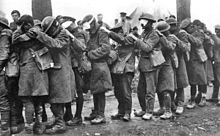
British 55th (West Lancashire) Infantry Division troops blinded by tear gas during the Battle of Estaires, 10 April 1918.
Following Operation Michael, Germany launched Operation Georgette against the northern English Channel ports. The Allies halted the drive with limited territorial gains for Germany. The German Army to the south then conducted Operations Blücher and Yorck, broadly towards Paris. Operation Marne was launched on 15 July, attempting to encircle Reims and beginning the Second Battle of the Marne. The resulting counterattack, starting the Hundred Days Offensive, marked their first successful Allied offensive of the war.
By 20 July the Germans were back across the Marne at their Kaiserschlacht starting lines, having achieved nothing. Following this last phase of the war in the West, the German Army never again regained the initiative. German casualties between March and April 1918 were 270,000, including many highly trained stormtroopers.
Meanwhile, Germany was falling apart at home. Anti-war marches became frequent and morale in the army fell. Industrial output was 53 percent of 1913 levels.
New states under war zone
In 1918, the internationally recognized Azerbaijan Democratic Republic, Democratic Republic of Armenia and Democratic Republic of Georgia bordering the Ottoman Empire and Russian Empire were established, as well as the unrecognized Centrocaspian Dictatorship and South West Caucasian Republic. Later, these unrecognized states were eliminated by Azerbaijan and Turkey.Further information: Partitioning of the Ottoman Empire
In 1918, the Dashnaks of the Armenian national liberation movement declared the Democratic Republic of Armenia (DRA) through the Armenian Congress of Eastern Armenians (unified form of Armenian National Councils) after the dissolution of the Transcaucasian Democratic Federative Republic. Tovmas Nazarbekian became the first Commander-in-chief of the DRA. Enver Pasha ordered the creation of a new army to be named the Army of Islam. He ordered the Army of Islam into the DRA, with the goal of taking Baku on the Caspian Sea. This new offensive was strongly opposed by the Germans. In early May 1918, the Ottoman army attacked the newly declared DRA. Although the Armenians managed to inflict one defeat on the Ottomans at the Battle of Sardarabad, the Ottoman army won a later battle and scattered the Armenian army. The Republic of Armenia signed the Treaty of Batum in June 1918.Allied victory: summer and autumn 1918
Main articles: Hundred Days Offensive and Weimar Republic
The Allied counteroffensive, known as the Hundred Days Offensive, began on 8 August 1918. The Battle of Amiens developed with III Corps British Fourth Army on the left, the French First Army on the right, and the Australian and Canadian Corps spearheading the offensive in the centre through Harbonnières. It involved 414 tanks of the Mark IV and Mark V type, and 120,000 men. They advanced 12 kilometres (7 miles) into German-held territory in just seven hours. Erich Ludendorff referred to this day as the "Black Day of the German army".The Australian-Canadian spearhead at Amiens, a battle that was the beginning of Germany’s downfall, helped pull the British armies to the north and the French armies to the south forward. While German resistance on the British Fourth Army front at Amiens stiffened, after an advance as far as 14 miles (23 km) and concluded the battle there, the French Third Army lengthened the Amiens front on 10 August, when it was thrown in on the right of the French First Army, and advanced 4 miles (6 km) liberating Lassigny in fighting which lasted until 16 August. South of the French Third Army, General Charles Mangin (The Butcher) drove his French Tenth Army forward at Soissons on 20 August to capture eight thousand prisoners, two hundred guns and the Aisne heights overlooking and menacing the German position north of the Vesle. Another "Black day" as described by Erich Ludendorff.
Meanwhile General Byng of the Third British Army, reporting that the enemy on his front was thinning in a limited withdrawal, was ordered to attack with 200 tanks towards Bapaume, opening the Battle of Albert, with the specific orders of "To break the enemy's front, in order to outflank the enemies present battle front" (opposite the British Fourth Army at Amiens). Allied leaders had now realised that to continue an attack after resistance had hardened was a waste of lives and it was better to turn a line than to try to roll over it. Attacks were being undertaken in quick order to take advantage of the successful advances on the flanks and then broken off when that attack lost its initial impetus.
The British Third Army's 15-mile (24 km) front north of Albert progressed after stalling for a day against the main resistance line to which the enemy had withdrawn. Rawlinson’s Fourth British Army was able to battle its left flank forward between Albert and the Somme straightening the line between the advanced positions of the Third Army and the Amiens front which resulted in recapturing Albert at the same time. On 26 August the British First Army on the left of the Third Army was drawn into the battle extending it northward to beyond Arras. The Canadian Corps already being back in the vanguard of the First Army fought their way from Arras eastward 5 miles (8 km) astride the heavily defended Arras-Cambrai before reaching the outer defences of the Hindenburg Line, breaching them on the 28 and 29 August. Bapaume fell on the 29 August to the New Zealand Division of the Third Army and the Australians, still leading the advance of the Fourth Army, were again able to push forward at Amiens to take Peronne and Mont Saint-Quentin on 31 August. Further south the French First and Third Armies had slowly fought forward while the Tenth Army, who had by now crossed the Ailette and was east of the Chemin des Dames, was now near to the Alberich position of the Hindenburg Line. During the last week of August the pressure along a 70-mile (113 km) front against the enemy was heavy and unrelenting. From German accounts, "Each day was spent in bloody fighting against an ever and again on-storming enemy, and nights passed without sleep in retirements to new lines." Even to the north in Flanders the British Second and Fifth Armies during August and September were able to make progress taking prisoners and positions that were previously denied them.

Close-up view of an American major in the basket of an observation balloon flying over territory near front lines
In nearly four weeks of fighting since 8 August, over 100,000 German prisoners were taken, 75,000 by the BEF and the rest by the French. Since "The Black Day of the German Army" the German High Command realised the war was lost and made attempts for a satisfactory end. The day after the battle Ludenforff told Colonel Mertz "We cannot win the war any more, but we must not lose it either." On 11 August he offered his resignation to the Kaiser, who refused it and replied, "I see that we must strike a balance. We have nearly reached the limit of our powers of resistance. The war must be ended." On 13 August at Spa, Hindenburg, Ludendorff, Chancellor and Foreign Minister Hintz agreed that the war could not be ended militarily and on the following day the German Crown Council decided victory in the field was now most improbable. Austria and Hungary warned that they could only continue the war until December and Ludendorff recommended immediate peace negotiations, to which the Kaiser responded by instructing Hintz to seek the mediation of the Queen of the Netherlands. Prince Rupprecht warned Prince Max of Baden "Our military situation has deteriorated so rapidly that I no longer believe we can hold out over the winter; it is even possible that a catastrophe will come earlier." On 10 September Hindenburg urged peace moves to Emperor Charles of Austria and Germany appealed to the Netherlands for mediation. On the 14 September Austria sent a note to all belligerents and neutrals suggesting a meeting for peace talks on neutral soil and on 15 September Germany made a peace offer to Belgium. Both peace offers were rejected and on 24 September OHL informed the leaders in Berlin that armistice talks were inevitable.
September saw the Germans continuing to fight strong rear guard actions and launching numerous counter attacks on lost positions, with only a few succeeding and then only temporarily. Contested towns, villages, heights and trenches in the screening positions and outposts of the Hindenburg Line continued to fall to the Allies, with the BEF alone taking 30,441 prisoners in the last week of September. Further small advances eastward would follow the Third Army victory at Ivincourt on 12 September, the Fourth Armies at Epheny on 18 September and the French gain of Essigny-le-Grand a day later. On 24 September a final assault by both the British and French on a 4 mile (6 km) front would come within 2 miles (3 km) of St. Quentin.With the outposts and preliminary defensive lines of the Siegfried and Alberich Positions eliminated the Germans were now completely back in the Hindenburg Line. With the Wotan position of that line already breached and the Siegfried position in danger of being turned from the north the time had now come for an assault on the whole length of the line.
The Allied attack on the Hindenburg Line began on 26 September including U.S. soldiers. The still-green American troops suffered problems coping with supply trains for large units on a difficult landscape.The following week cooperating French and American units broke through in Champagne at the Battle of Blanc Mont Ridge, forcing the Germans off the commanding heights, and closing towards the Belgian frontier. The last Belgian town to be liberated before the armistice was Ghent, which the Germans held as a pivot until Allied artillery was brought up. The German army had to shorten its front and use the Dutch frontier as an anchor to fight rear-guard actions.
When Bulgaria signed a separate armistice on 29 September, the Allies gained control of Serbia and Greece. Ludendorff, having been under great stress for months, suffered something similar to a breakdown. It was evident that Germany could no longer mount a successful defence.
Meanwhile, news of Germany's impending military defeat spread throughout the German armed forces. The threat of mutiny was rife. Admiral Reinhard Scheer and Ludendorff decided to launch a last attempt to restore the "valour" of the German Navy. Knowing the government of Prince Maximilian of Baden would veto any such action, Ludendorff decided not to inform him. Nonetheless, word of the impending assault reached sailors at Kiel. Many rebelled and were arrested, refusing to be part of a naval offensive which they believed to be suicidal. Ludendorff took the blame—the Kaiser dismissed him on 26 October. The collapse of the Balkans meant that Germany was about to lose its main supplies of oil and food. The reserves had been used up, but U.S. troops kept arriving at the rate of 10,000 per day.
Having suffered over 6 million casualties, Germany moved towards peace. Prince Maximilian of Baden took charge of a new government as Chancellor of Germany to negotiate with the Allies. Telegraphic negotiations with President Wilson began immediately, in the vain hope that better terms would be offered than by the British and French. Instead Wilson demanded the abdication of the Kaiser. There was no resistance when the social democrat Philipp Scheidemann on 9 November declared Germany to be a republic. Imperial Germany was dead; a new Germany had been born: the Weimar Republic.
Armistices and capitulations
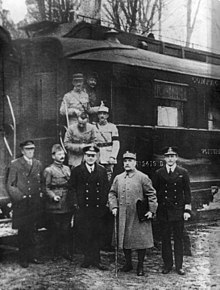
In the forest of Compiègne after agreeing to the armistice that ended the war, Foch is seen second from the right. The carriage seen in the background, where the armistice was signed, later was chosen as the symbolic setting of Pétain's June 1940 armistice. It was moved to Berlin as a prize, but due to Allied bombing it was eventually moved to Crawinkel, Thuringia, where it was deliberately destroyed by SS troops in 1945.
On 24 October 1918, the Italians began a push which rapidly recovered territory lost after the Battle of Caporetto. This culminated in the Battle of Vittorio Veneto, which marked the end of the Austro-Hungarian Army as an effective fighting force. The offensive also triggered the disintegration of Austro-Hungarian Empire. During the last week of October declarations of independence were made in Budapest, Prague and Zagreb. On 29 October, the imperial authorities asked Italy for an armistice. But the Italians continued advancing, reaching Trento, Udine and Trieste. On 3 November Austria–Hungary sent a flag of truce to ask for an Armistice. The terms, arranged by telegraph with the Allied Authorities in Paris, were communicated to the Austrian Commander and accepted. The Armistice with Austria was signed in the Villa Giusti, near Padua, on 3 November. Austria and Hungary signed separate armistices following the overthrow of the Habsburg Monarchy.
Following the outbreak of the German Revolution, a republic was proclaimed on 9 November. The Kaiser fled to the Netherlands. On 11 November an armistice with Germany was signed in a railroad carriage at Compiègne. At 11 a.m. on 11 November 1918; "the eleventh hour of the eleventh day of the eleventh month"; a ceasefire came into effect. Opposing armies on the Western Front began to withdraw from their positions. Canadian Private George Lawrence Price is traditionally regarded as the last soldier killed in the Great War: he was shot by a German sniper at 10:57 and died at 10:58.
Allied superiority and the stab-in-the-back legend, November 1918
In November 1918 the Allies had ample supplies of men and materiel to invade Germany, yet at the time of the armistice, no Allied soldier had set foot on German soil in anger and Berlin was still almost 900 mi (1,400 km) from the Western Front. The Kaiser's armies had also retreated from the battlefield in good order which enabled Hindenburg and other senior German leaders to spread the story that their armies had not really been defeated. This resulted in the stab-in-the-back legend which attributed Germany's losing the war not to its inability to continue fighting (even though up to a million soldiers were suffering from the 1918 flu pandemic and unfit to fight), but to the public's failure to respond to its "patriotic calling" and the intentional sabotaging of the war effort, particularly by Jews, Socialists and Bolsheviks.A formal state of war between the two sides persisted for another seven months, until signing of the Treaty of Versailles with Germany on 28 June 1919. Later treaties with Austria, Hungary, Bulgaria and the Ottoman Empire were signed. However, the latter treaty with the Ottoman Empire was followed by strife (the Turkish War of Independence) and a final peace treaty was signed between the Allied Powers and the country that would shortly become the Republic of Turkey, at Lausanne on 24 July 1923.
Some war memorials date the end of the war as being when the Versailles treaty was signed in 1919; by contrast, most commemorations of the war's end concentrate on the armistice of 11 November 1918. Legally the last formal peace treaties were not signed until the Treaty of Lausanne. Under its terms, the Allied forces divested Constantinople on 23 August 1923.

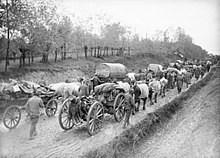

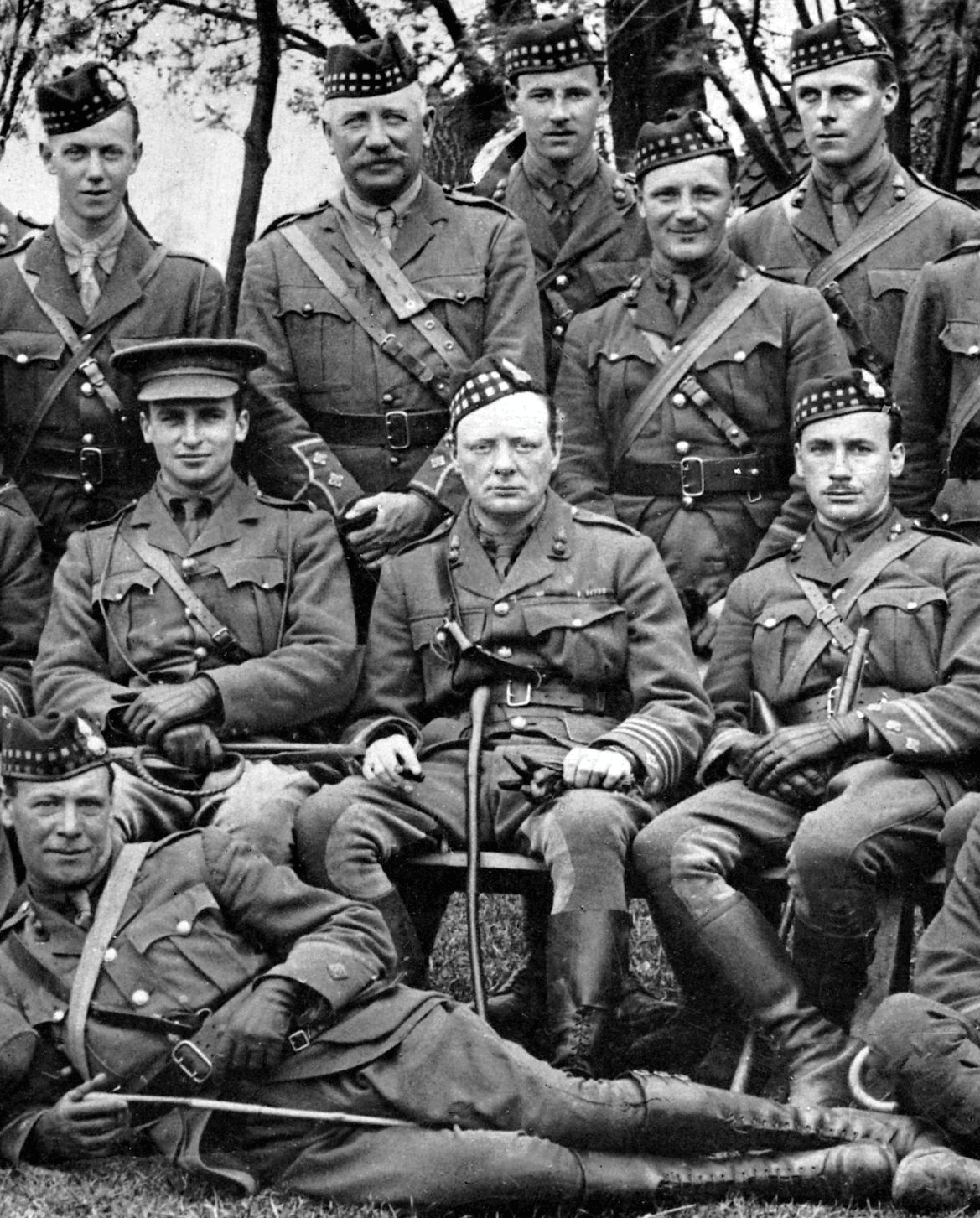

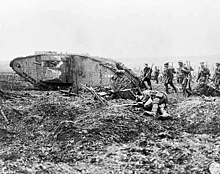
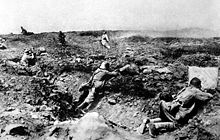


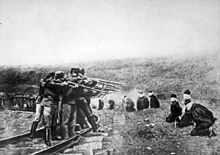

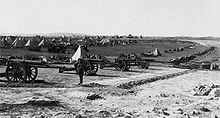


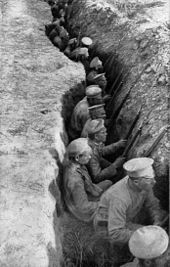




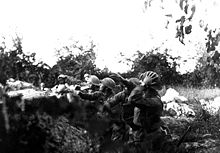

0 comments:
Post a Comment